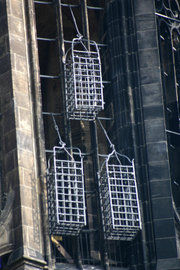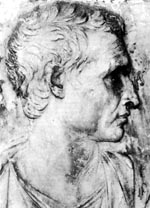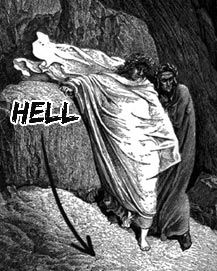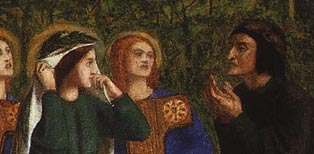Notes for Pages 70-79.
< 59-69 | Notes Index | 80-89 >
Page 70: And most of this courtyard is from somewhere in the UK, although I’ve hacked up the architecture sufficiently so that I can no longer figure out exactly where. Maybe it’s better that way.
Page 71: I didn’t try to get too creative with this one, because Gothic architecture is terrifying (you  should see the file at its original size). This is pretty much St. Lambert’s Church, in the Westphalian city of Münster, built in the 14th century.
should see the file at its original size). This is pretty much St. Lambert’s Church, in the Westphalian city of Münster, built in the 14th century.
The primary alteration is in the steeple; the original is delicately honey-combed, and also features three permanently-attached iron cages from which the defeated corpses of the leaders of the Anabaptist rebellion were suspended and exposed to the elements in 1535.
They were apparently all in favor of polygamy and the renunciation of private property, so they didn’t have much of a running start.
Page 72: And again with the stealing, although this time the source is the John Rylands Library. Despite appearances, it’s not actually Gothic, it’s neo-Gothic. The library, now part of the University of Manchester, was commissioned in the 19th century by a rich widow who preferred to leave lasting cultural legacies instead of eating bon-bons and going to the races wearing ostrich-feather hats.
The irony of taking a secular British Victorian library modeled on Gothic religious architecture and retrofitting it to be a German Gothic cathedral repurposed as a secular Enlightenment library is not lost on me.
Incidentally, this is the first (and possibly only) fully digital page of the comic. I owe a special thanks to Jenn Manley Lee for helping me find, reconstruct, and then generate the tile pattern on the floor. Go read her comic, she knows what she’s doing.
Page 73: Hail Luther, full of grace. Like that big globe Lucien’s leaning on? It has the constellations on it!
Page 75: Book mold is brutal, nasty stuff. You can make it go dormant by keeping books temperature and moisture-controlled, and there are some modern chemicals to help that process along, but there really isn’t a “cure” even today, and certainly not one that worked consistently in the 18th century. You do what do you can, quarantine the survivors, and hope for the best.
Luther is stepping on an early 16th-century edition of the works of Rome’s foremost bucolic poet and author of the Aeneid, Publius  Vergilius Maro (or, Virgil. To his pals). A lot of portraits of Virgil from after his death make him look like Legolas; don’t believe ’em. The man had a nose and jawline for the ages.
Vergilius Maro (or, Virgil. To his pals). A lot of portraits of Virgil from after his death make him look like Legolas; don’t believe ’em. The man had a nose and jawline for the ages.
He’s tucked in with Dante for cross-reference with the Divine Comedy. Dante has Virgil act as a tourguide to the author’s stand-in, the Pilgrim, for the first two books of the Comedy. Virgil, at the behest of Dante’s angel girlfriend and the Virgin Mary, gets a day off to take the Pilgrim on a world-class tour of Hell and the lower-rent areas of Purgatory.
Virgil is only damned by virtue of, oh rats, having been born before Christianity got off the ground, so for the most part he’s an upstanding guy, patiently teaching the squirming mortal Pilgrim all of Hell’s ups and downs (mostly downs, natch), bitching out some of the region’s nastier inhabitants, and going pale at the screams of his fellow inmates. I totally had a crush on him.
He’s particularly well-qualified for the tourguide job, because the Aeneid also features a trip to an eternal underworld with a curiously  strong focus on contemporary Italian politics.
strong focus on contemporary Italian politics.
The Aeneid generally makes me twitch, because it was commissioned by Emperor Augustus, and as such features a delightful cameo in which Aeneas, our ancient Etruscan hero, learns that, wow, there’s going to be these dudes? In Rome’s glorious future? Called the CAESARS? And this one particular one of them? Augustus? Totally a bad-ass!
Propaganda by way of Homeric fanfic, in short. Virgil requested that the Aeneid (unfinished, mind you), be destroyed upon his death, but no dice; undergraduates are reading it to this very day. Poor bastards.
Page 76: “La Vita Nuova” (“The New Life”) was Dante’s first major work, collecting his writings from around 1283 to 1293. It’s a collection of poetry and short essays, mostly devoted to Dante’s longtime crush object, a girl named Beatrice – from the moment Dante spies her as a nine year-old from his balcony, to her marriage to an appropriate fellow, to well after her death at an early age.
In case you’re feeling creeped out, don’t worry; this was “courtly love”, a very cerebral and semi-religious exercise which didn’t really  involve, say, actual conversation or physical contact. The Pre-Raphaelite painters just LOVED this material.
involve, say, actual conversation or physical contact. The Pre-Raphaelite painters just LOVED this material.
This was a very edgy work, because it wasn’t written in Latin, still the chosen format even four hundred years later in Luther’s time.
Okay, I’ll shut up about Dante now.
“that fruit merchant in Znaim” – yeah, again, books were pricey and hard to come by, and often your best bet for affordably acquiring them was to scavenge, beg, flatter, or woo some rich merchant or faltering noble into bequeathing their library to you. Lucien’s job has a healthy dose of morbidity to it.
Page 77: I’m never going to stop finding this funny. For the record; Luther’s the period equivalent of 5’8″ or 5’9″ (175 cm). Lucien’s around 6’2″ (188 cm). Ariana’s right around 6’0″ (183 cm). Haaaaaa!
And, well, I say “period equivalent” because nutrition in the 18th century wasn’t quite so polished as it is today; we’ve almost all gotten a bit taller since then.
Page 78: Being a librarian, as an official, fulltime job, was still rather unusual around this time. Generally it was a part-time office occupied by a faculty member, or one filled by several people in turn. Needless to say, having a young woman do that job would be even odder.
Access to the library was relatively restricted (definitely not open to the public), more valuable volumes were frequently chained to their shelves, organizational systems were proprietary, and so on. Heck, the first encyclopedia was barely getting warmed up. In short, it was the Wild West for information technology workers.
Page 79: Remember those journals sitting on the hat shelf in the boys’ room back in Luther’s hometown? No? Theological ‘zines? the “’62 circulatory” is one of those, collecting a bunch of grad student essays from that year at Heidelberg or some such. Ariana’s a completist collector.